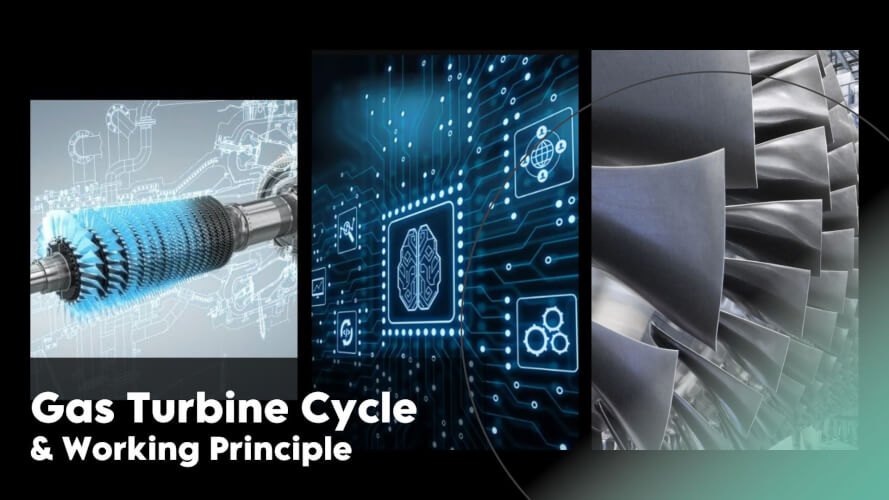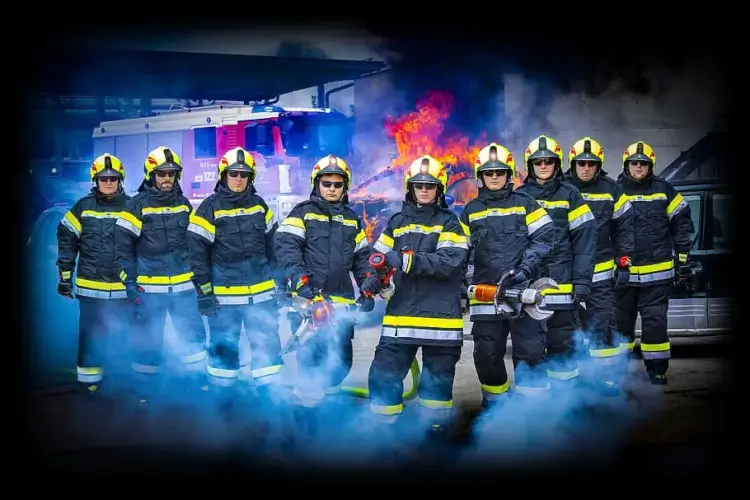Gas turbines, often known as gas engines, are widely employed for a variety of purposes around the world. It is the most prevalent and well-known type of turbine. These turbines are the most widely used power production devices today. These turbines are primarily used to generate low-cost energy utilizing gas as a working fluid. We explored steam turbines, wind turbines, and water turbines in prior posts. As a result, the focus of this blog will be on various aspects of the gas turbine.
The Working Principle and Cycle of a Gas Turbine
The Brayton cycle is used to power the gas turbine. The air-fuel mixture is compressed, burned, fed through a gas turbine, and released during this cycle.
Air is used as a working medium in the working cycle of a gas turbine. The stages of a gas turbine’s operation are as follows:
- Suction Process
- Compression Process
- Combustion Process
- Turbine Section
- Electricity Generation
Despite the fact that this cycle is not optimal for open circle gas turbines, it is still employed with minor modifications. They’re ideal for use in a closed-cycle gas turbine. There are four steps in this cycle:
- Isentropic compression in the compressor
- pressure heat addition in the combustor’s combustion chamber.
- power turbine’s isentropic expansion.
- Pressure heat rejection
The gas turbine’s compressor has been developed in such a way that it receives the flowing atmospheric air, increasing the pressure. In this technique, the air is compressed up to 30 times its normal pressure. Fuel is sprayed into the air when air passes through this part. Then, by igniting the fuel with air, more energy is added, and the combustion produces a high-temperature flow.
In the gas turbine cycle, combustors are either silo, annular, or can-annular. The annular combustors’ combustion chambers are doughnut-shaped, while the can-annular combustion chambers are can-shaped, and unlike the annular, it contains several combustion chambers. Silo combustors have one or more combustion chambers and are larger than the other two types. Large-scale activities require silos, while small-scale applications require the other two.
The combustion chamber’s output, a high-temperature pressured gas, will enter a turbine, which will provide shaft work to drive the compressor. The excess energy will be released in the exhaust gases and used for external labor or reused for other purposes, such as operating a second power turbine. The fourth phase of the gas turbine cycle (Brayton cycle) is removed in an open cycle gas turbine with open systems because these gas turbines do not utilize the same air for cooling the working fluid (this cooling is the last step of the mentioned cycle.) This fourth cycle is also present in closed-cycle ones.
These pieces are all connected by one or more shafts, and they are collectively referred to as gas turbines or gas generators. The steam and gas turbine control system helps to improve the safety and performance of the system. DS200TCQAG1B, DS200TCQCG1A, and DS200LDCCH1A are some examples of the control system components.
Gas Turbine Cycle Application
These turbines may power a variety of devices, including electrical generators, gas compressors, pumps, aircraft, ships, tanks, and trains, thanks to the gas turbine cycle.
A closed-cycle gas turbine differs from an open-cycle gas turbine.
The fundamental difference between these two gas turbines is that the open cycle one releases exhaust gases into the atmosphere rather than recirculating them. The fourth stage of the gas turbine cycle occurs exclusively in closed-cycle gas turbines that reuse the same air for cooling the working fluid, as we discussed in the steps of the gas turbine cycle.
A gas turbine’s working principle in the oil and gas industry
It’s important to remember the following points:
- Instead of connecting with a turbine, the turbine is connected with a compressor or a pump in the oil and gas production process.
- When a gas turbine is used to drive a compressor, an arrangement similar to that of a steam turbine is considered.
- The auxiliary plumbing system requires header tanks and lubrication oil.
- An exhaust system with ducting to a few heat recovery systems, such as a process heater or a steam raising plant, should be considered.
- All machinery should have provisions for maintenance and operation.
- Combustion air must be delivered to the turbine burner from a safe point outside the compressor house. Inlet silencer and filter are most likely essential devices.
Gas turbine advantages and downsides
One of the major benefits of gas turbine engines is that they are much smaller than reciprocating engines with similar power ratings. They also have fewer moving parts than reciprocating engines, which means they require less maintenance and cost less.
Gas turbines, on the other hand, have several drawbacks. The core engine of a gas turbine can be costly because it employs exotic materials that are pricey. Another disadvantage of gas turbines is that they are less sensitive to variations in power demand as compared to reciprocating engines. One of the most notable differences is that reciprocating engines are far more efficient than gas turbines at idle speed. They can, however, run on a range of fuels and have lower peak combustion pressures than these engines.
Gas turbines are extremely dependable when you need a lot of power for a long time. Another thing to keep in mind about gas turbines is that they have a very high power-to-weight ratio when compared to reciprocating engines. In addition, the waste heat generated by the gas turbine cycle is virtually totally dissipated in the exhaust. Not to add that the gas turbine has less vibration than a reciprocating engine due to the steady spinning of the main shaft.
Overall, whether the fourth stage of the gas turbine cycle is required or not, as well as which engine to select when purchasing a turbine, is heavily dependent on your application and the location where the turbine will be installed.
Summary
A gas turbine operates on the same basic idea as an internal combustion reciprocating engine. In both situations, the air is forced into the prime mover, which compresses it and heats it through the combustion process, raising the pressure even higher and finally releasing the enlarged products through the exhaust.
In the case of an internal combustion reciprocating engine, however, the charge is injected intermittently into the engine cylinder. The flow of working fluid in a gas turbine, on the other hand, is continuous and smooth, with the exception of constant volume or explosion gas turbines, which are no longer widely utilized.
Also Read: Benefits of comparing and buying a car insurance policy







